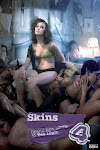Hollyoaks
How are sound, camera and mis-en-scene used to effect in this scene from Hollyoaks?
In Soap Operas the way in which sound, camera and mis-en-scene are used are vital to add the narrative, visuals and overall effect of the scenes. An example of this is the television soap Hollyoaks. In a highly action packed and dramatic episode all of these are used to add to the dramatic narrative; also the episode uses some aspects of film and TV editing that are not usually used in other soap operas such as Eastenders or Coronation Street.
There a many different types of sound used in film and TV but in soap operas you mainly find diegetic, non-diegetic, ambient sounds and asynchronous sound. These are all present in the scene that I analysed but I also noticed that incidental/atmospheric music, sound effects (SFX) and a sound bridge were used, which is unusual for television soaps.
In the scene the breathing of the character Max is amplified and exaggerated by the use of SFX, which also exaggerates the splashing of the water as he jumps in. These sounds in turn then become dominant in the sound mix. The diegetic sounds in the scene came from the little boy Tom screaming and banging on the car window, Max’s heavy breathing and the short snippet of dialogue from characters Claire and OB. The diegetic sounds highlight the fact that woods are desolate, dull and dreary and that something is about to happen. At the end of the scene the diegetic sound becomes totally silent and it is focused on the atmospheric music, which dominates the scene and becomes more dominant in the soundmix. This adds an air of mystery and leads the audience to believe Max is dead…or is he?
The amplifications of particular sounds by the SFX, help to add drama and tension to the scene, in turn driving the narrative as a whole. The sound bridge which plays through numerous shots and credits help to add continuity and realism to the scene. It makes the events happening seem more realistic and help to create a feeling of sadness, loss and desperation. The incidental music also help by making Claire appear to be the “Bad Guy” by the use of trumpets, drum and violins, again another example of how it helps to drive the narrative.
The mis-en-scene also helps a great deal in helping the audience gain a realistic representation of the characters and the setting in the scene, which includes costume. Claire is a character that is represented in the sense as violent and rather dark character. This is highlighted by her costume, which consists of dark colours such as black and purple. This is very significant as she is a very cold and heartless character and her clothing has been used to show the audience this aspect of her character. Her make up is also very pale which again makes her come across as cold, evil and lifeless with no feeling and her reluctance to help Max whilst he is drowning also show this. Max is the first character that we are introduced to in the scene and he comes across as the weak and vulnerable character. This is due to the fact that he has very pale make up which makes him appear lifeless and could also links to the idea of death.
There is also a blood red coat in the middle of the water that is a connation of danger, blood and also could be seen as a warning signal. It stands out from the rest of the scene because of its deep and eye-catching colour whilst the rest of the scene is low lit.
The setting which is in a forest near a lake could symbolize life drifting and fading away, which is exactly what happens to Max’s character at the end of the scene. The water from the lake could symbolise many things and has many connotations: peace, life, death, purity, cleanliness which all could be intertwined with the narrative in some way.


